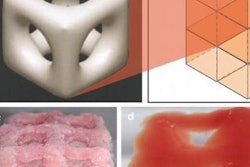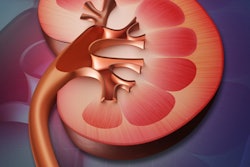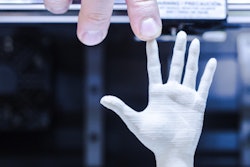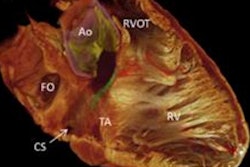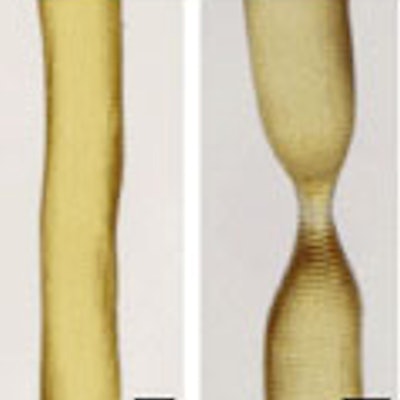
Arterial thrombosis is potentially fatal, and is a major risk factor leading to strokes and heart attacks. One way to study this problem is to exploit precise manufacturing techniques like 3D printing, and mimicking the interaction between vessel walls and blood flow is critical to effectively replicating healthy and diseased blood vessels in vitro.
Researchers in the Netherlands have now created a more accurate blood-vessel model that effectively replicates the formation of a blood clot caused by stenosis defects, the narrowing of a blood vessel that can lead to disease (Lab on a Chip, 8 August 2017, Vol. 17:16, pp. 2785-2792). The researchers, from the University of Twente and Utrecht University, developed a microfluidic blood-vessel model using layered stacks of CT angiography (CTA) data combined with sterolithography, a light-based 3D-printing process.
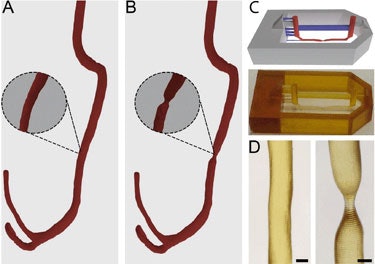 3D-printed microfluidic blood vessel chip, with and without stenotic defect. (A) Healthy and (B) diseased 3D-printed blood vessels; (C) image of the 3D model (top) and picture of the final 3D model with support structures removed (bottom); and (D) close up of healthy and diseased blood-vessel channels. Image reproduced from Lab on a Chip CC BY 3.0.
3D-printed microfluidic blood vessel chip, with and without stenotic defect. (A) Healthy and (B) diseased 3D-printed blood vessels; (C) image of the 3D model (top) and picture of the final 3D model with support structures removed (bottom); and (D) close up of healthy and diseased blood-vessel channels. Image reproduced from Lab on a Chip CC BY 3.0.To create the model, the researchers first 3D printed a negative mold with the precise blood-vessel structure. They then poured a mixture of polydimethylsiloxane (PDMS) and a crosslinking agent mixture into the mold, which was then cured to create the vessel channel. By lining the vessel channel with endothelial cells and perfusing patient blood at normal arterial shear rates, the researchers established the platelet aggregation that forms a blood clot, and they also observed an increase in the backflow downstream of the stenosis defect.
Improvements in geometry
The anatomically accurate blood vessel model developed by these researchers achieves an even distribution of shear stress across the vessel, which makes it much more clinically relevant than typical in vitro models. The key difference is the geometry of the fabricated blood vessel because most previous microfluidic models have been produced with a square channel where vessel cells can be seeded and perfusion can occur. These square channel walls do not provide an accurate representation of a blood vessel, with differing shear forces being applied to the corners and flat sections of the square vessel.
Results produced from this 3D model can be cross-referenced easily with fluid-flow simulations in silico to instill a systems biology approach to research, and the researchers believe the use of patient CTA data could lead to the development of patient-specific blood-vessel models. The resolution and control of the blood vessels produced by the technique also makes it suitable for modeling alternative vascular diseases, including chronic conditions like vascular dementia. Further development of this model could eventually lead to a fully stratified approach to vascular disease research, which in turn would reduce the number of animals used in research studies.
Geoffrey Potjewyd is a doctoral student contributor to medicalphysicsweb, working in the division of neuroscience and experimental psychology, as part of the CDT in Regenerative Medicine at the University of Manchester in the U.K. He is studying the neurovascular unit in relation to vascular dementia and Alzheimer's disease, using biofabrication, biomaterials, and stem-cell based techniques.
© IOP Publishing Limited. Republished with permission from medicalphysicsweb, a community website covering fundamental research and emerging technologies in medical imaging and radiation therapy.




